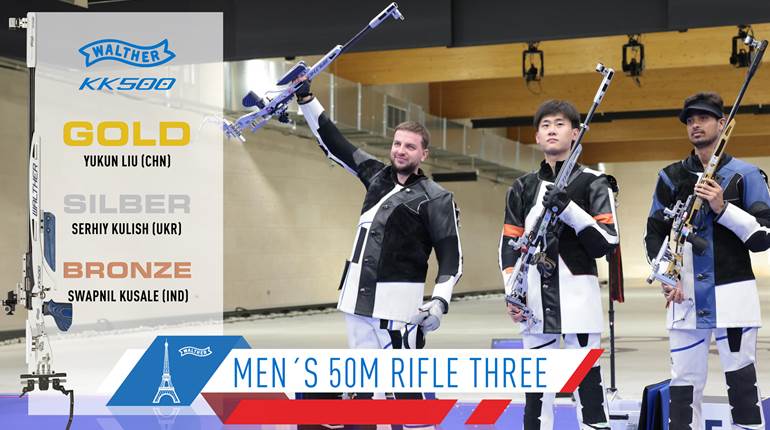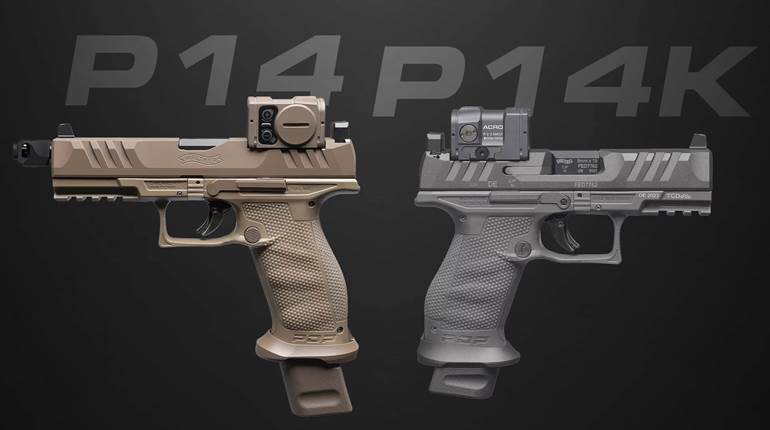
Walther has been making quality handguns with a reputation for reliability and accuracy since the introduction of its Model 1 sometime around 1908. But the company remained relatively unfamiliar to most American shooters until 1962, when a PPK-concealing James Bond started saving the world on the silver screen. Sixty years later, the iconic pistol continues to overshadow some of Walther’s latest innovations, such as the PPX.
Part of the reason is that the recently released PPX isn’t as sexy as its older, more famous sibling. It’s a personal protection, duty-size gun with an overall length of 7.3 inches, height of 5.6 inches and a 1.3-inch waistline. The Walther lineage shows in the design, however, and the gun arrives at a price that will catch the attention of budget-conscious agencies, armed citizens and collectors-its suggested retail price is only $449.
The polymer-frame PPX has a hand-filling grip with an unusually curvaceous backstrap. That’s not to say it will be love at first sight, but during testing the 9 mm Luger version was comfortable and confidence-building in regard to recoil management. Subtle finger indentations on the frontstrap improve purchase, along with texturing around the grip’s entire circumference. The bottom of the non-changeable backstrap has a small, recessed lanyard loop.
Both sides of the Tenifer-coated steel slide have five serrations on the front and another six grooves in back to aid manipulation, even with sweaty hands. Some of that purchase area is surrendered to a “Walther” logo roll marked into the left front of the slide, but the classy touch didn’t compromise anything during testing. On the same side there’s also a “PPX” logo.
Up top, the sights are low-profile and provide a three-dot sight picture. The non-adjustable front sight blade is 0.140-inch thick and the white dot is about 0.1 inch in diameter-large enough for fast acquisition. At the rear, a windage-adjustable U-notch-style sight has a dot on each side. The notch opening measures 0.152-inches wide, and it is 0.1-inch tall. A loaded-chamber viewport is located at the top back of the breechblock.
The slide is beveled on the front, sides and back to minimize the chances of getting hung up during the draw stroke. It’s finished in flat black and matches the rest of the gun well. A four-groove accessory rail is located on the dustcover for mounting weaponlights and/or lasers. It’s slightly more than 2" long.
The slide-stop and disassembly lever are on the left side of the gun. It is not necessary to pull the trigger when disassembling the PPX. Remove the magazine and double-check that the gun is empty. Then lock back the slide, rotate the disassembly lever (clockwise) and, while maintaining a grip on the slide, depress the slide-stop lever. The slide, barrel, guide rod and captive spring can now slide off the front.
As the pistol arrives from the factory, the magazine release is located in the spot familiar to most Americans-on the left side of the grip, where it and the lower trigger guard meet. A screwdriver and a small punch are all that is required to move the magazine-release button to the right side of the frame for left-handed use.
The 9 mm PPX comes with two 16-round magazines (or 14-round versions in .40 S&W) with witness holes on both sides to indicate the number of remaining cartridges. A slightly recessed button on the bottom speeds floorplate removal for magazine cleaning and maintenance. During testing, magazine changes were fast, sure and almost intuitive. Both magazines also released with authority and cleared the gun quickly.
There are no external safeties. There is a pair of drop safeties-trigger and disconnector-and a firing pin block internally.
The squared trigger guard’s front has six horizontal grooves molded into the polymer, and internally there’s plenty of room to work the trigger with gloves. The trigger has a smooth face and no paddle-as is increasingly common on striker-fired handguns-because the PPX is hammer fired.
Walther calls the system a pre-cocked double-action. Insert a magazine, rack the slide and the hammer is pre-cocked, but rests in recessed cutouts in the slide and polymer frame-flush and pretty much invisible from the sides. As the trigger is squeezed, the hammer starts a backward movement for about 1/4 inches until it releases. When the slide travels rearward under recoil, it pre-cocks the hammer, changes direction due to spring pressure, picks up a fresh cartridge and finally comes back into battery.
On the test gun there was 0.33 inches of trigger travel before the hammer released on the firing pin. Let-off was crisp and consistent at 6 pounds, 4 ounces.
There were no stoppages or failures to feed during the range session, but two times the slide failed to lock back on an empty magazine with the Remington UMC load. It happened once with the American Eagle ammunition, too.
Despite a relatively high bore axis, recoil was tame and target reacquisition fast. This is one of those handguns that is a pleasure to shoot, so it won’t be relegated to second-tier duties due to comfort or performance issues.
We may never shoot like James Bond, but with the PPX it’s no longer mandatory to break the bank if you want to take home a handgun with Walther performance and reliability.
Importer: Walther Arms, Inc., 7700 Chad Colley Blvd., Fort Smith, AR 72916;
(479) 242-8500
Cartridge: 9 mm Luger (tested), .40 S&W
Action Type: recoil-operated, semi-automatic center-fire pistol
Frame: polymer
Slide: Tenifer-coated steel
Rifling: six-groove, 1:9.84" RH twist
Magazine: detachable-box, 16-round capacity (9 mm Luger)
Sights: fixed front, windage-adjustable rear notch, three-dot
Trigger: pre-cocked double-action, 6-lb., 4-oz. pull
Overall Length: 7.3"
Width: 1.3"
Height: 5.6"
Weight: 27 ozs. (empty)
Accessories: carrying case, owner’s manual, lock, spare magazine
Suggested Retail Price: $449







































